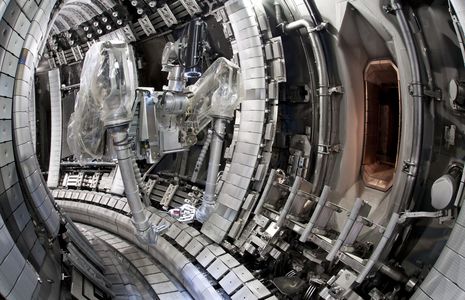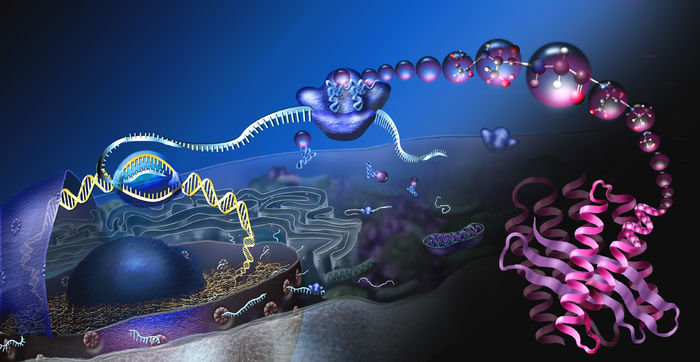Scientists are right to be excited about nuclear fusion
Nuclear fusion has been back in the news recently. But why are scientists excited? Vyas Burra explains the principles underlying nuclear fusion and sheds light on the new milestones reached

Nuclear fusion has been in the news recently. You may have heard about a “breakthrough” in technology back in February, but what is it all about? Why are scientists so fascinated by nuclear fusion, and what does it mean for the way we might generate electricity in the years to come?
First of all, what even is nuclear fusion, and how can it be used to generate electricity? You’ve probably heard about nuclear power stations, which use the principle of nuclear fission. Both fission and fusion are based around modifying nuclei, which are the dense cores of atoms, made up of the particles protons and neutrons. Fission is where a large nucleus is split into smaller nuclei, releasing a lot of energy in the process which can be used to generate electricity. Examples of elements with larger nuclei include uranium, which can split into elements with smaller nuclei such as krypton and barium. This produces much radioactive waste, which has to be disposed of correctly and safely.
Nuclear fusion is the opposite of fission; it involves combining much smaller nuclei to form a larger one, again releasing energy in the process. The Sun depends upon fusion to release energy, where it fuses around 620 million tonnes of hydrogen every second to form helium, fuelling life on Earth in the process. In theory, replicating this process should be able to release bounds of energy which could be harnessed to power our lives, but the reality is slightly more complicated than that.
“Replicating this process should be able to release bounds of energy which could be harnessed to power our lives”
Both fission and fusion require energy to get started, so for it to be worthwhile spending money on making a reaction happen, you need to get more energy out than what you put in. But this statement in itself does not make sense; you may remember from school physics lessons that you can’t “make” energy; you can only transfer it from one form to another. So, what’s happening here?
This can be explained by a principle called “mass-energy equivalence”, which essentially states that every object that has mass also has an intrinsic energy. This is explained by Einstein’s famous formula, E = mc2 (where “E” is energy, “m” is mass, and “c2” is the speed of light squared). Therefore, regardless of whether you’re dealing with fission or fusion, energy is always conserved; it just so happens that in fusion, some atomic mass is converted to energy and released, which is what can be used to fuel electricity generators.
Nuclear fusion would be an ideal source of energy. It is clean, as it does not directly produce radioactive waste like fission does (although some radioactive waste does come from reaction products reacting with the materials of the reactor itself). The amount of energy released can be up to four times as much as that from fission, which is the most efficient source of electricity generation currently available. Estimates show that a few grams of raw materials could release enough energy to sustain one person in a developed country for over sixty years. Fusion is also much safer than fission; as the conditions for the reactions to occur are challenging to achieve, if they are not met the reaction simply stops.
This all sounds great – so why has fusion not kicked off yet? Well, one of the reasons is how difficult it is to perform fusion reactions on Earth; fission reactions require far less extreme conditions than fusion reactions. Fission involves splitting a large nucleus, which is relatively easy compared to fusion, where two positively charged nuclei are forced together close enough to make them combine. The Sun is able to do this as it is so massive, and so its own gravity and already high temperature forms an ideal environment for fusion to occur. That level of gravitational force is not available in a small nuclear reactor on Earth, so immense pressures and temperatures must be replicated for fusion to occur.
This is where the tokamak comes in. A tokamak is a device that uses powerful magnets to confine fuel for fusion in the form of a plasma and is the leading design for fusion reactors. The Joint European Torus (JET) is the world’s largest and most advanced tokamak, and is based in Oxfordshire. The temperatures managed in the tokamak are immense, at around 150 million degrees Celsius. This is hotter than anywhere else in the entire solar system; our Sun’s temperature pales in comparison, which at its hottest is around 15 million degrees Celsius. The magnets in the tokamak keep the searing hot plasma away from the walls, as there aren’t many materials available that can withstand such high temperatures.
JET has been in the news recently for doubling the energy output from fusion compared to their own record, set back in 1997. The reactor still requires much more energy than what can be harnessed, but this new record is a huge step in the right direction. The current aim in fusion reactor research is to achieve “breakeven”, which is where the reactor releases the same amount of energy as what is put in. A new fusion reactor, ITER, is being built in France, which will be much larger than JET. It is predicted that if the same conditions and principles are applied to ITER as they have been to JET, not only could breakeven be achieved, but we could get to a point where ten times the energy put in in the form of electricity could be released, which would be revolutionary for the future of electricity production.
Advances in the field of nuclear fusion are very promising, but we are still many decades away from having commercial fusion reactors. Given the current climate emergency, and the hunt for sustainable energy, clean fusion power could not come quickly enough. If research is successful, and if we do get to a point where nuclear fusion becomes mainstream, we could see ourselves living in a greener world with an almost limitless supply of electricity in the not-too-distant future.
 News / Cambridge academics stand out in King’s 2026 Honours List2 January 2026
News / Cambridge academics stand out in King’s 2026 Honours List2 January 2026 Interviews / You don’t need to peak at Cambridge, says Robin Harding31 December 2025
Interviews / You don’t need to peak at Cambridge, says Robin Harding31 December 2025 Comment / What happened to men at Cambridge?31 December 2025
Comment / What happened to men at Cambridge?31 December 2025 News / Varsity’s biggest stories of 202531 December 2025
News / Varsity’s biggest stories of 202531 December 2025 News / Unions protest handling of redundancies at Epidemiology Unit30 December 2025
News / Unions protest handling of redundancies at Epidemiology Unit30 December 2025










